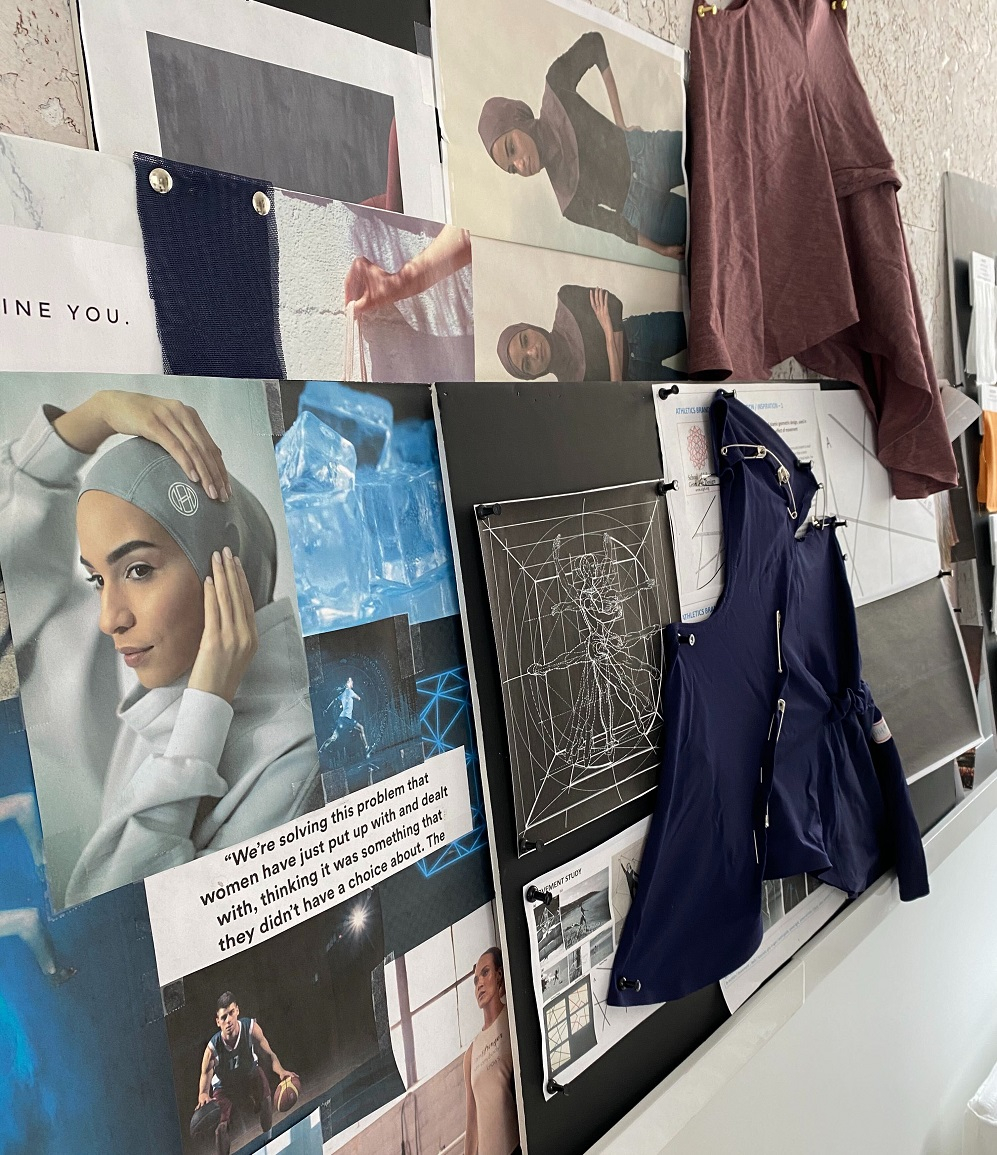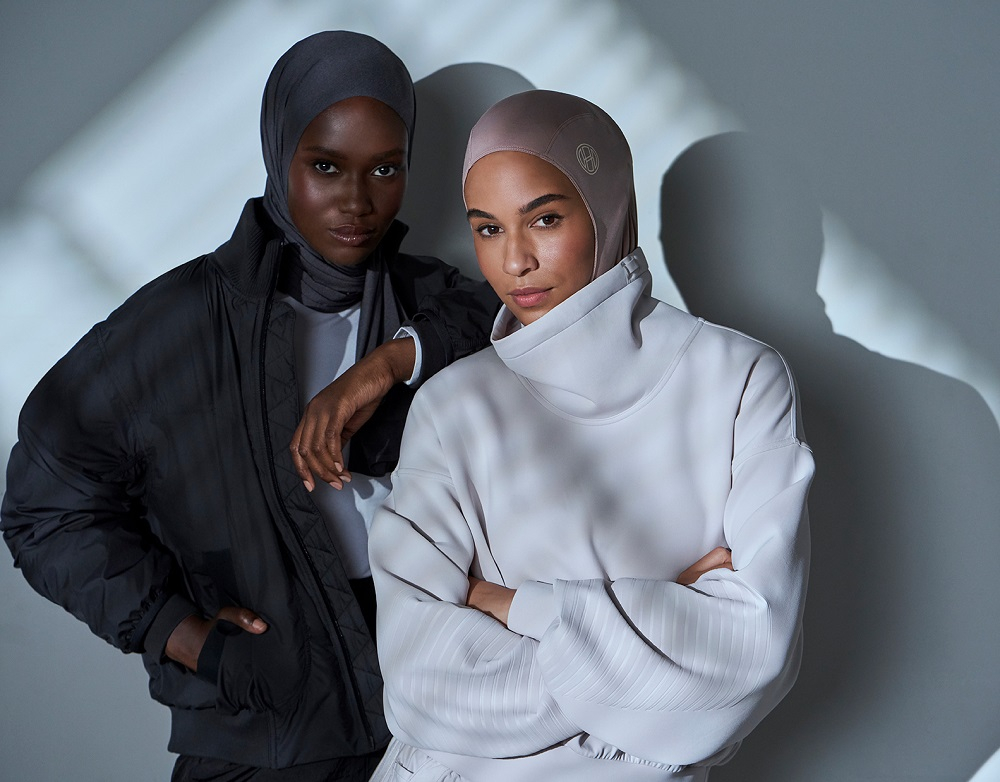Behind the Scenes of Haute Hijab Sport – How Design, Tech and Innovation Led the Way
Fashion
|
Sep 29, 2020
|
10 MIN READ

A mood board laying out the inspiration for Haute Hijab Sport.
Nearly two years ago, the work began with vision-board planning, research and deep thinking around this unfulfilled need – how can Muslim women be included in conversations around athletics? How can we make their fitness, sport, playing and athletic experiences better? How can we provide women with the options they deserve – hijabs in which they can work out and compete in freely, securely, comfortably and beautifully?
As our CEO Melanie writes in her letter introducing Haute Hijab Sport, “For too long Muslim women have been left out of the conversation around athletics. Women who wear hijab have been banned from playing their sport professionally, disqualified for wearing hijab in school sports and altogether overlooked and regarded as a group of women who aren't athletic – or worse, aren't interested in sports. And yet, Muslim women are more engaged in sport than ever.”
The conception, design and development of Haute Hijab Sport was a monumental task that has spanned months of work by our team. From envisioning the design; to understanding movement concepts that married design, form, function and Islamic spirituality concepts; to intense research and development of prototypes, testing those prototypes; more research on finding the perfect material that was lightweight, breathable, cooling for your skin and made of eco-friendly material; to infinite tweaking, fixing and a million other technical and logistical aspects – Haute Hijab Sport is one of the most important and complicated hijab collections we have ever undertaken.
The design and technical process from start to finish is a fascinating story. What goes into designing the perfect sport hijab (let alone four of them)? How do you account for different head (and ear and forehead) sizes, the plethora of movements our heads make as we work out, how much hair a woman may have, the kinds of activities she will be undertaking and the way she wants to style and wear her hijab?
Where do you even start?
Understanding Form and Fit as a Starting Point

A spec created by the design team of the head measurements for Haute Hijab team members as part of the research.
“Every designer starts with a creative direction,” says Haute Hijab’s former Director of Design & Innovation, Mireia Lopez. “Without that, you can’t start anything.” Mireia used an inside-out approach built on design thinking and human-centered design theory. “We wanted to change how the Muslim woman feels and her experience when working out in a hijab – that she wants to be beautiful, powerful and comfortable.”
Mireia, who is a Creative Director and Milo Tricot consultant and the founder of the Blinded by Color project (@blindedbycolorproject), based the design of Haute Hijab Sport on the Laban Theory, a study of modern dance and movement pioneered by Rudolph von Laban. “Laban understands systems, form and movement,” she says “It studies the body and the effort, the shape and space in which it moves.” By studying these movements and the shape and space our heads take up, one can begin to create measurements to understand balance and how a hijab may move and fit on a woman while engaging in physical activities.
While aesthetics are important, nothing matters if the fit of a sport hijab isn’t right, says Mireia. “We need to study the ears, the forehead, how our neck moves to know how to solve [the fit] problem; how to solve the comfort problem. Sometimes, in the research process, one comes up with excellent designs that look amazing in a sketch … but doesn’t look amazing on a three-dimensional head. We have to understand how the woman herself will move around and how will this hijab empower her to achieve mind, body and soul in balance. The form needs to feed the purpose.”
The Pain Points of Muslim Women Who Move
In researching the design and conception of Haute Hijab Sport, dozens of Muslim women were interviewed about how they work out, what their pain points are, what does and does not work for them in an athletic hijab and many other questions. Mireia, who isn’t Muslim but works out intensively, says she knew she couldn’t materialize the concept of being fully covered while engaging in fitness and sport. So, as part of her research, she went to her local gym several times to work out in competitors’ hijabs during high intensity group classes.
“I don’t wear long sleeves because I have a [medical] overheating problem. I overheat in a tank top, so I needed to know how it felt in a hijab. She donned different hijabs with her tank top and worked out several times. “The people at my gym have known me for years, and they were so confused! It was so wrong that it was funny.” But in putting herself through the experience, she discovered everything wrong with other athletic hijabs, including form, fit and especially fabric.

Former Design and Innovation Director Mireia Lopez trying on an early prototype as she worked out in her local gym.
“That was a major thing for me. We needed to give women a cool fabric that was super thin and gentle on the skin,” she says. She also discovered the challenge of getting a one-piece hijab on and off. “The ninja-type was most difficult to take off. Because of [a woman’s] hair, the size doesn’t work for everyone. [I learned that] if you have a lot of hair, you should be able to wear your hijab loose, and if you have less hair, [you should be able to] tighten it up around a smaller bun.”
The other often reported pain point was hijabs that don’t stay in place – slippage. This, however, led to another problem faced by the fashion industry in general: How do you create standard measurements for hijabs when women have different sizes of heads? The design team collected tons of data through research and the measuring of many women – head circumference, ear sizes, forehead size and slope, neck measurements and even body height.
This led to the development of two sizes in the one-piece sport hijabs and underscarf – the FlexFit, Criss-Cross and Tech Cap.
Even then, getting standardized measurements and the fit right took a few prototypes. Arlene Severet, a technical designer with Haute Hijab, says the first prototype for the FlexFit proved to be too wide with too much fabric in the back. “We wanted there to be enough fabric that it should fit comfortably over the head, but if a woman did not want to use the internal cord to scrunch it up, it should still look good.”
It was challenging to find designs that were functional, beautiful and appealed to the team as a whole while developing standards of measurement, Mireia says. “Standard measurements are a good methodology to control the quality of the brand, because then your customer knows you for that fit. But, it’s painful because not everyone has the same kind of head and everyone has their own personal style. And, that is so difficult to do not only in hijabs, but in fashion in general.”
To accommodate different style preferences, eventually the team developed four hijabs in the collection to be worn five ways depending on what style and design a woman prefers - the FlexFit, the Criss-Cross, the Tech Cap and the Tech Wrap (the latter two can be worn together if a woman chooses).
The fit of the hijabs was one of the most challenging parts of the whole design process, says Mireia. “When your pants don't fit that well or look weird around your bottom, you can cover yourself or tweak it here and there. But when something doesn’t feel right on your face or your head, you’re going to feel very conscious about it. [A hijab] is what you see around a woman’s face. So, I feel that pain.”
A Fabric that Ties It All Together

A mood board for the design, inspiration and fabric choices for Haute Hijab Sport.
The final major pain point was finding the right fabric for the hijabs that addressed overheating and sweat while being comfortable against the skin, stretchy and made from a more sustainable material. That came at the beginning of the design process rather than the end. “If you want to be the most innovative and sustainable Muslim company and you want to empower Muslim women, I’m going to give you the fabric for that,” says Mireia.
Haute Hijab Sport is made with S.Cafe fabric, which is fast drying, has odor control, UV protection, can cool down the temperature of a woman's skin (when working out) by 1 to 2 celsius compared to common fabrics and is made out of coffee grounds. More importantly, it’s a circular material, meaning the fabric manufacturer uses waste as a source to make a polymer/fiber that may be used as a fabric.
Regular polyester is oil-based petroleum and is extremely toxic, says Mireia. “The only way to substitute a durable, sustainable material is to use fabrics made from waste in a circular design, and that’s only been happening in the past few years.”
The company that produces S.Cafe fabric is not only known for its use of coffee grounds but also for the methods used to make the fiber in a way that is safer for the environment. “You have to understand how the material is being produced,” says Mireia. “Is it compliant with water usage? Are harmful chemicals being used?
"Our fabric is certified by Bluesign@. As an independent authority, its criteria guarantees the highest degree of assurance to consumers and ensures that the products were manufactured with responsible use of resources and the lowest possible impact on people and the environment," explains Mireia.
All of this was taken into consideration when partnering with the manufacturer that produces S.Cafe fabric. Using such a sustainable fabric does come at an expense though, but it’s worth it to be able to provide quality hijabs that are more eco-friendly.
The cooling property of the fabric is especially important because, as the design team points out, when you are covered up and exercising, you will sweat and heat up. Hijab-wearing Muslim women know this well. That the Haute Hijab Sport hijabs can cool women 1-2 degrees is what makes it different (among other things) from its competitors.
Getting to the Finish Line
Once Haute Hijab Sport reached the stage of prototypes, the work became more and more technical, drawing on the expertise of technical designer Arlene. She worked through numerous iterations of prototypes for each hijab, measuring and remeasuring and comparing against the history of the products. Each time fittings would occur, corrections were made and comments sent back to the vendor to make tweaks.
“We gave pattern corrections, adjusted measurements for the two sizes and through it all tried to decipher – would this work for the customer? What would work for the customer? And while that’s all happening, there’s a lot of washing to see what would happen with the fabric,” Arlene says.

A model photo shoot with two of our final Haute Hijab Sport hijabs!
One of the seemingly small things with the Haute Hijab Sport hijabs that actually was a very technical and important undertaking by the design team was making sure the seams of the hijabs were smooth, durable and strong. The seams are laser cut and bonded, says Arlene, meaning it’s not a traditional hem. For example on the Tech Wrap, having a bonded seam allows for the smoothest of edges – you don’t have to fold over the hijab as you wrap it around your face as is the case when styling most hijabs. The other technical and tricky part of the design was making sure seams lay flat on the head with the FlexFit and Criss-Cross hijabs.
In between all this, the design team also facilitated ongoing lab dips to test out the colors chosen for the hijabs. Two or three lab dips occurred to finalize the colors. “And the same thing goes with the trim, bungee cords and elastic. They need to be dyed to match,” says Arlene. “You don’t want your gray fabric to look a little different from your elastic. You want it to be cohesive.”
The timeline of production for Haute Hijab Sport was particularly tight, especially when the COVID-19 global pandemic changed everything. But having a great working relationship with the factory where the hijabs are produced helped with the multiple iterations of the hijabs. “When you start working with a factory and you go [can] through three, five or multiple prototypes, that can extend the timeline. And the team that works with you doesn’t make [a lot of] money until you place the order,” explains Haute Hijab Product Development Manager Lily Steele.
“But for us, these hijabs were so important. The fit had to be right. The production had to be right. It had to be perfect. We had four prototypes, and the fact that we were able to get the factory to do that [before we finally placed our order] was pretty impressive,” Lily says, crediting Mireia with her creativity in working with the factory.
To get to the finish line and bring you Haute Hijab Sport has been an exhaustive and exciting project that took nearly two years to complete, from recognizing the immense need for a collection of Sport hijabs that gave Muslim women the quality, care and options they needed; to the design, technical and production processes of it all.
If you’ve made it this far in the story, you now have a deeper understanding of everything it took to bring these hijabs to you! We tried to think of everything that was important to and for Muslim women in our goal to bring you a superior collection of sport hijabs.
These hijabs are for movements that matter. And, as Melanie says, no more makeshifts. No more compromises.
Subscribe to be the first to know about new product releases, styling ideas and more.
What products are you interested in?

